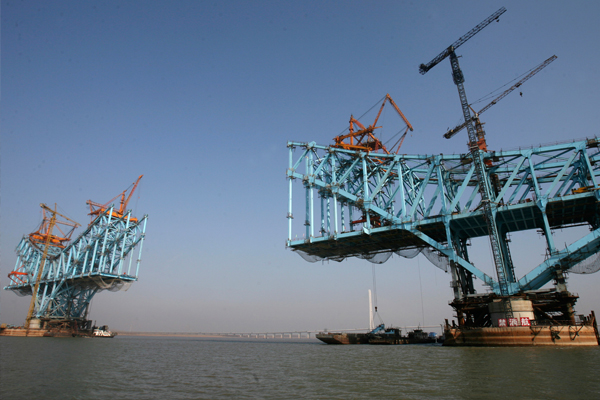
The Yangtze River Delta region is known for its entrepreneurship, business acumen and innovation, being home to companies such as Alibaba and a number of rising law firms. But as China carries out its economic transformation, it is facing some tough challenges and companies need to think out of the box. Similarly, law firms need to be savvy if they want to stay ahead of the pack. Li Shangjing reports.
As an old saying goes, “Just as there is paradise in Heaven, there is Suzhou and Hangzhou down on earth.”
Suzhou and Hangzhou are located in the Yangtze River Delta (YRD) region, and this area has been of special significance to the Chinese since ancient times. As one of China’s economic and social centres, the YRD region is praised for its unrivalled economic innovation, abundant talent and splendid culture.
The YRD region includes Shanghai Municipality, Jiangsu Province and Zhejiang Province, covering an area of 210,700 square kilometres. According to 2010 statistics, the region, which occupies just 2.1 percent of China’s total land area and 11 percent of its population, generated 21.7 percent of the country’s gross domestic product, 24.5 percent of fiscal revenue and 47.2% of total imports and exports. In 2013, per capita gross national product in the YRD exceeded $10,000, making it Number 1 in terms of economic strength and, with its sophisticated urban system, the most socially developed region in China.
Forest Ni, a Nanjing-based senior partner of AllBright Law Offices, told ALB that compared to other city clusters in China, the YRD region enjoys more stable development. “The Beijing-Tianjin-Hebei region is more politically focused, while the Pearl River Delta region has developed relatively earlier, and now except for Shenzhen, cities there lack substantial advantages. As far as these city clusters are concerned, the YRD region is still the fastest-growing economic region in China,” he said.
The YRD, Pearl River Delta, Beijing-Tianjin-Hebei, Chengdu-Chongqing and Yangtze River midstream city clusters are considered China’s five major national-level city clusters. Currently, the YRD city cluster is one of the six globally recognised world-class city clusters, and it is committed to becoming the world’s biggest metropolitan area by 2018.
According to Zhang Ne, senior partner at the Shanghai office of Co-effort Law Firm, there are multiple reasons why the YRD region leads in financial innovation and business acumen. First, it boasts a strong real economy. Second, this region is traditionally affluent in China, with ample private capital, keen enthusiasm and willingness to invest among the public. Third, there is a lot of talent in this region, which also benefits from Shanghai’s financial spillover, making it easier to achieve commercial and financial innovation.
He also stressed the role that local governments play in the YRD region. “Local governments in this region are special because the officials are technocrats. Many administrative and economic officials I know have deep knowledge of the economy. Though the ‘small government, large market’ model is preferred, in China, government guidance and support are still needed, especially at the initial phase of developing a particular industry,” said Zhang.
For the 13th Five-Year Plan period, Shanghai, Jiangsu and Zhejiang will adopt very different development models that have with their own merits. The YRD city cluster will change from the model of “a single core led by Shanghai” to “a single core supported by multiple centres”. With increasingly accessible transportation and waning traditional position advantages, a region’s innovative vitality will become a key factor in competing with its rivals.
Back to topSOUTHERN JIANGSU IN THE LEAD
Jiangsu shows robust growth, but development is unbalanced across the province.
Indicators including legal services paint a picture of relatively big discrepancy between southern and northern Jiangsu. Northern cities like Huai’an and Suqian still lag far behind their southern counterparts such as Suzhou, Wuxi and Changzhou. Judging from lawyer fee revenue alone, the amount charged by lawyers in Suzhou, the highest in Jiangsu, is almost 20 times that of Suqian.
Cities in southern Jiangsu boast substantial advantages, and even Nanjing, the provincial capital, falls behind Suzhou, Wuxi and Changzhou in terms of fees charged per lawyer. “Though Nanjing is the provincial capital, we are not as good as Suzhou or Wuxi in many aspects. It is really pitiful,” Chen Yang, director of Nanjing-headquartered Jiangsu Fides Law Firm, said in an interview with ALB.
In 2014, the top three Jiangsu cities in terms of total lawyer fee revenue are Suzhou with RMB 1.061 billion, Nanjing with RMB 678 million and Wuxi with RMB 665 million, according to the latest data from the Jiangsu Provincial Department of Justice. To put those figures in context, Nanjing had 3,024 lawyers, Suzhou 2,827 while Wuxi 1,580 in 2014.
The southern Jiangsu model as represented by Suzhou, Wuxi and Changzhou has long depended on investment and export processing. Suzhou is the most notable example. Both the China–Singapore Suzhou Industrial Park and the Suzhou New District are industry clusters championed by the government and dominated by foreign investment. They are mostly populated by technology-focused foreign companies with a huge economic output.
In the newly released list of top 100 counties in small and medium-sized Chinese cities by overall economic strength, the top four spots were occupied by counties in Jiangsu, and three of them are located in Suzhou. Furthermore, Suzhou achieves new breakthroughs in patents every year, sustaining its front-runner position nationwide in terms of the number of patents applied for and the number of patents granted.
“That southern Jiangsu has a developed economy has historical reasons. Town and village enterprises in Jiangsu have developed very well since the economy was reformed and opened up. Our development is supported by organisations and local governments, so we have a relatively good foundation. In addition, people from southern Jiangsu have inherent business acumen, are very practical and accept new things quickly,” said Fides’ Chen Yang.
Currently, law firms in Jiangsu are predominantly small and midsize firms with a headcount of less than 30. In Nanjing, there are 265 city-level law firms, 95 percent of which are small firms with less than 30 lawyers. Two of them – Jiangsu Sundy Law Firm and Beijing Zhong Yin (Nanjing) Law Firm – have more than 100 lawyers. Only three law firms have a headcount of 50 to 100, namely Jiangsu Dongheng Law Firm, Jiangsu FD Yongheng Law Firm and Yongheng Partners.
Back to topZHEJIANG LOOKS FOR NEW WAYS
Zhejiang has taken a different approach: by relying on private companies, marketisation and division of labor, it has formed numerous small industrial belts. These endogenous economic and industrial models have great vitality. After 30 years of development, Zhejiang businessmen have become an important force with considerable clout across China. They are the exporters of entrepreneurship.
Encouragement of entrepreneurship and the intrinsic pioneering spirit of Zhejiang businessmen have helped create large private companies including Hangzhou-based Alibaba. For the NYSE-listed Alibaba Group, whose initial public offering is so far the largest ever in the U.S., its impact has long gone beyond that of a local company. But the Zhejiang e-commerce ecosystem formed on the back of Alibaba is still exerting its influence across the region.
Zhejiang’s entrepreneurial zeal also applies to law firms in the province, which could explain their high ranking in China. Zhejiang lawyers lead their domestic peers in terms of total headcount and revenue generation. According to the most recent data from the Hangzhou Lawyers Association, Zhejiang lawyers rank sixth in China in terms of total headcount, fourth in terms of revenue generation and third in terms of fees charged per lawyer.
Similar to Jiangsu, many cities in Zhejiang are among the top performers in terms of lawyer fee charged, thanks to its multi-centre development approach. In 2014, Hangzhou, the provincial capital, posted RMB 2.037 billion in total lawyer fees charged, accounting for 40.58 percent of the provincial total. But fee charged per lawyer is only RMB 415,000 in Hangzhou, lower than that of its fellow Zhejiang cities Shaoxing, Zhoushan and Ningbo.
Small and midsize law firms account for about 92 percent of firms in Zhejiang. As of October 31, 2015, there were approximately 388 law firms in Hangzhou, 357 of which are small and medium-sized firms with a headcount of less than 30. Eleven of these firms have a headcount of 51 to 100, while only four of them have over 100 employees.Though most of the law firms in Hangzhou are small or medium-sized, there are also big regional players. For example, Zhejiang T&C Law Firm has a total of 151 professionals.
“Over these years, lawyers in Hangzhou have been closely following the needs and directions of the legal-service market, actively exploring new legal-service niches and striving to provide more professional and specialised services. Law firms are becoming either specialised or full-service providers,” explained Wang Lixin, partner at Zhejiang T&C Law Firm, to ALB.
Hangzhou-based T&C also relies on Zhejiang’s entrepreneurship to expand its operations. Wang Lixin said that next year is the firm’s 30th anniversary, and T&C will continue implementing its sector-focused specialisation approach and expanding its global vision as it grows.
Back to topFINANCIAL RISKS ACCELERATING IN YRD
Though Jiangsu’s and Zhejiang’s local economies have always led the pack, an active economy has also created more severe financial risks.
Recently, non-performing loans (NPL) and bad debts transfer have swept China into turbulence. The YRD region, which takes pride in financial innovation, is also the first in line to experience the effects of this alarming trend.
According to the latest “Special Analytical Report on China’s Credit Risks” released by Unbank, both outstanding NPLs and the NPL ratio continued to rise in some regions in the second quarter of 2015. NPL ratio has been up 0.27 and 0.1 percentage points, respectively, in Zhejiang’s and Jiangsu’s banking industries from the beginning of the year, with regional NPLs rising across the board. The banks’ new NPLs are concentrated in regions like YRD, with signs of gradual spread to other places, the report shows.
“I know many businesses that used to be thriving have encountered difficulties in recent years. It can even be said that they face survival risks. Some of them have incurred huge bad debts that they have never seen before. As a lawyer, my recommendations for dealing with bad debts are to leave troubled areas and to focus on core strengths. It means that an enterprise needs to change its philosophy, give up heavy assets, leave the areas where it is losing money and instead focus on its most profitable core business to become asset-light and revitalise the entire operation,” said Zhang Ne, senior partner at the Shanghai office of Co-effort Law Firm, in an interview with ALB.
In addition to bad debts, high-profile financial crimes are also frequently uncovered in Jiangsu and Zhejiang. For example, Wu Ying, the former sixth richest woman in China who was convicted in 2009 for of illegal fundraising, is from Zhejiang Dongyang. Xu Xiang, the so-called “private equity guru” who was arrested in early November, made his fortune in Ningbo, Zhejiang.
Local law firms are quick to spot such financial risks caused by the economic downturn. Jiangsu Fides Law Firm has a long-standing reputation as a commerce-focused firm, but the Wu Ying and Xu Xiang cases have led its founding partners to rethink the firm’s role.
“In our nine years of development, we have always positioned ourselves as a law firm focusing on commercial practices. But now, I feel that our understanding of commerce is too narrow. Previously, we did not take criminal cases, and only practised in financing, finance, securities and equity based on the court’s definition of commerce. But recently, we find that this does not work,” said Fides’s Chen Yang.
She further pointed out that under current conditions, it has become increasingly important for law firms to improve their ability to handle white-collar crimes and administrative litigations. This is also the key of the new positioning of her firm. “It is impossible for us to avoid cases that involve economic crimes,” she said.
Prosperity does not come without peril, and this could explain why financial risks are more ubiquitous in this area. But even that won’t stop YRD from becoming a driving force in China’s economy, especially as it seeks to recover from a slump and regain its dynamism. Given the unique context, law firms here sure have a lot to achieve.
Back to top


